Odyssey 100
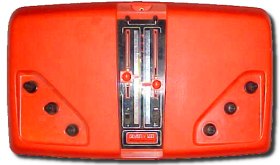 The Game: A simple version of video ping-pong; players use three knobs, one to control horizontal movement, one to control vertical movement, and a third to control the “English” or spin of the ball. (Magnavox, 1975)
The Game: A simple version of video ping-pong; players use three knobs, one to control horizontal movement, one to control vertical movement, and a third to control the “English” or spin of the ball. (Magnavox, 1975)
Memories: Caught flat-footed by the success of Atari‘s Pong home console, Magnavox found itself struggling to hang onto the very market that Ralph Baer‘s original Odyssey console had created in the first place. Perhaps not surprisingly, Magnavox turned back to the Odyssey, not just for inspiration but to – at least in a limited fashion – put the machine back on the market. [read more]

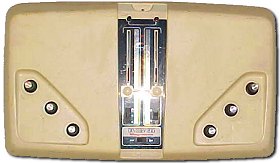 Talk about upscale. The Odyssey 200, released not long after the
Talk about upscale. The Odyssey 200, released not long after the 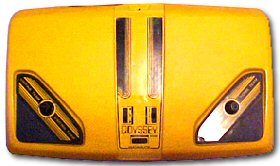 Taking Atari’s lead for the first time, the Odyssey 300 – in its bright yellow shell – saw the console abandoning the trio of horizontal/vertical/English controls that had been in place since the original Odyssey. In addition to mimicking the all-in-one controls of Atari’s Pong, Odyssey 300 – still boasting the standard Tennis, Hockey and Smash variations of its predecessors – introduced digital on-screen scoring. The Odyssey games were no longer reliant on the honor system: at 15 points, one player won the game. [read more]
Taking Atari’s lead for the first time, the Odyssey 300 – in its bright yellow shell – saw the console abandoning the trio of horizontal/vertical/English controls that had been in place since the original Odyssey. In addition to mimicking the all-in-one controls of Atari’s Pong, Odyssey 300 – still boasting the standard Tennis, Hockey and Smash variations of its predecessors – introduced digital on-screen scoring. The Odyssey games were no longer reliant on the honor system: at 15 points, one player won the game. [read more]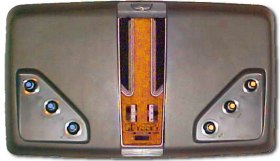 With the same trio of games as the Odyssey 400 – Tennis, Hockey/Soccer and Smash – the Odyssey 500, released in 1976 by Magnavox, would appear to not be much of an upgrade, but in fact, it’s an absolutely critical turning point for home video games: the Odyssey 500 did away with squares and rectangles to represent the player, and introduced character sprites – hardware-generated characters that roughly mimicked the shape of a human being. [read more]
With the same trio of games as the Odyssey 400 – Tennis, Hockey/Soccer and Smash – the Odyssey 500, released in 1976 by Magnavox, would appear to not be much of an upgrade, but in fact, it’s an absolutely critical turning point for home video games: the Odyssey 500 did away with squares and rectangles to represent the player, and introduced character sprites – hardware-generated characters that roughly mimicked the shape of a human being. [read more]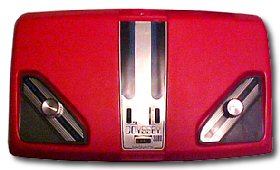 After the baffling backward step of the Odyssey 400, Magnavox’s Odyssey 2000 saw a return to the Pong-inspired, single-paddle control scheme, with digital scoring restored as well – Magnavox had decided to rest the Brown Box design (and the subsequent variations on it) permanently in favor of, once again, the General Instruments AY-3-8500 “Pong on a chip” processor. Packaged in a red casing, this would be the last anyone would see of the smoothly rounded-off, integrated Odyssey console. The next system to bear the name would return to its roots – with wired controllers that weren’t necessarily stuck to the main console – and look forward, with a futuristic new design that stands up even today. [read more]
After the baffling backward step of the Odyssey 400, Magnavox’s Odyssey 2000 saw a return to the Pong-inspired, single-paddle control scheme, with digital scoring restored as well – Magnavox had decided to rest the Brown Box design (and the subsequent variations on it) permanently in favor of, once again, the General Instruments AY-3-8500 “Pong on a chip” processor. Packaged in a red casing, this would be the last anyone would see of the smoothly rounded-off, integrated Odyssey console. The next system to bear the name would return to its roots – with wired controllers that weren’t necessarily stuck to the main console – and look forward, with a futuristic new design that stands up even today. [read more]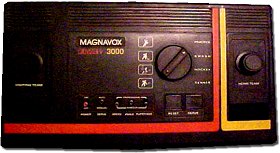 It adds nothing to the Odyssey 2000’s “four action-packed video games,” but the Odyssey 3000 is a quantum leap in the design aesthetic of the console itself. Finally breaking away from the basic casing design that had been in place since the Odyssey 100, Odyssey 3000 packs four games (well, really just three plus a Tennis “practice mode”) into a sleek, futuristic-looking black wedge with highlights that almost anticipate – believe it or not – the look of the computer screens in Star Trek: The Next Generation (though to be more realistic, it may have been influenced by the design line of Atari’s Fuji logo). The controllers are detachable but hardwired, and nestle snugly into the console itself. [read more]
It adds nothing to the Odyssey 2000’s “four action-packed video games,” but the Odyssey 3000 is a quantum leap in the design aesthetic of the console itself. Finally breaking away from the basic casing design that had been in place since the Odyssey 100, Odyssey 3000 packs four games (well, really just three plus a Tennis “practice mode”) into a sleek, futuristic-looking black wedge with highlights that almost anticipate – believe it or not – the look of the computer screens in Star Trek: The Next Generation (though to be more realistic, it may have been influenced by the design line of Atari’s Fuji logo). The controllers are detachable but hardwired, and nestle snugly into the console itself. [read more]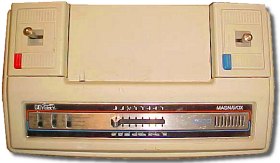 The final member of the Odyssey stand-alone console family tree, the Odyssey 4000 boasts more games than any of its predecessors since Ralph Baer’s original Odyssey, and was only the second of the dedicated Odyssey consoles to feature color (after the experimental Odyssey 500). And for those who have ever held the joystick of a Magnavox Odyssey2 in their hands, the Odyssey 4000 offers another familiar element – its joysticks are exactly the same mold as those of the Odyssey2, only rotated 90 degrees, and sporting some major differences in internal mechanisms. Though multidirectional, the joysticks are designed to favor vertical movement and offer some resistance to horizontal movement. [read more]
The final member of the Odyssey stand-alone console family tree, the Odyssey 4000 boasts more games than any of its predecessors since Ralph Baer’s original Odyssey, and was only the second of the dedicated Odyssey consoles to feature color (after the experimental Odyssey 500). And for those who have ever held the joystick of a Magnavox Odyssey2 in their hands, the Odyssey 4000 offers another familiar element – its joysticks are exactly the same mold as those of the Odyssey2, only rotated 90 degrees, and sporting some major differences in internal mechanisms. Though multidirectional, the joysticks are designed to favor vertical movement and offer some resistance to horizontal movement. [read more]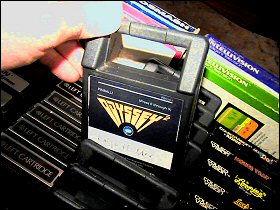 The Game: A virtual pinball machine is presented, complete with flippers, bumpers, and the ability to physically “bump” the table to influence the motion of the ball. Per standard pinball rules, the object of the game is to keep the ball in play as long as possible. (Ralph Baer, 1978 – unreleased prototype)
The Game: A virtual pinball machine is presented, complete with flippers, bumpers, and the ability to physically “bump” the table to influence the motion of the ball. Per standard pinball rules, the object of the game is to keep the ball in play as long as possible. (Ralph Baer, 1978 – unreleased prototype)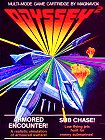 The Game: War is pixellated, blocky hell on the Odyssey2! In Armored Encounter, two combatants in tanks circumnavigate a maze peppered with land mines, searching for the optimum spot from which to blow each other to kingdom come. In Sub Chase, a bomber plane and a submarine, both maneuverable in their own way, try to take each other out without blasting any non-combatant boats routinely running between them (darn that civilian shipping!). In both games, the timer is counting down for both sides to blow each other straight to hell. (Magnavox, 1978)
The Game: War is pixellated, blocky hell on the Odyssey2! In Armored Encounter, two combatants in tanks circumnavigate a maze peppered with land mines, searching for the optimum spot from which to blow each other to kingdom come. In Sub Chase, a bomber plane and a submarine, both maneuverable in their own way, try to take each other out without blasting any non-combatant boats routinely running between them (darn that civilian shipping!). In both games, the timer is counting down for both sides to blow each other straight to hell. (Magnavox, 1978) The Game: In Baseball!, you are, quite simply, one of two teams playing the great American game. If you’re up at bat, your joystick and button control the man at the plate and any players on base. If you’re pitching, your button and joystick control how wild or straight your pitches are, and you also control the outfielders – you can catch a ball on the fly, or pick it up and try to catch the other player away from his bases. (Magnavox, 1978)
The Game: In Baseball!, you are, quite simply, one of two teams playing the great American game. If you’re up at bat, your joystick and button control the man at the plate and any players on base. If you’re pitching, your button and joystick control how wild or straight your pitches are, and you also control the outfielders – you can catch a ball on the fly, or pick it up and try to catch the other player away from his bases. (Magnavox, 1978)